Ț: Difference between revisions
m convert special characters (via WP:JWB) |
Updated remarks on the accessibility of T-comma |
||
| Line 6: | Line 6: | ||
== Software support == |
== Software support == |
||
[[T]]-[[comma]] was not part of the early [[Unicode]] versions, it was introduced only in Unicode 3.0.0 (September 1999) at the request of the Romanian national standardization body. Thus, some legacy systems do not have [[font]]s compatible with it, for example [[Microsoft]]'s [[Windows XP]] require installing the European Union Expansion Font Update<ref>[http://www.microsoft.com/downloads/details.aspx?FamilyID=0ec6f335-c3de-44c5-a13d-a1e7cea5ddea&DisplayLang=en European Union Expansion Font Update]</ref>. Full support of this letter has been available on [[Macintosh]] computer since [[Mac OS X]] and on [[Personal computer|PC]] since [[Windows Vista]]. Although accessibility issues are a concern only on legacy systems, because of inertia and/or ignorance some newly-produced Romanian texts still use [[Ţ]] ([[T]]-[[cedilla]], available from Unicode version 1.1.0, June 1993). |
|||
The letter is placed in Unicode in the Latin Extended-B range, under "Additions for Romanian", as the "Latin capital letter T with comma below" (U+021A) and "Latin small letter t with comma below" (U+021B).<ref>Unicode code charts. [https://www.unicode.org/charts/PDF/U0180.pdf Latin Extended-B: Range 0180–024F]</ref> In HTML these can be encoded by <code>&#x021a;</code> and <code>&#x021b;</code>, respectively. |
The letter is placed in Unicode in the Latin Extended-B range, under "Additions for Romanian", as the "Latin capital letter T with comma below" (U+021A) and "Latin small letter t with comma below" (U+021B).<ref>Unicode code charts. [https://www.unicode.org/charts/PDF/U0180.pdf Latin Extended-B: Range 0180–024F]</ref> In HTML these can be encoded by <code>&#x021a;</code> and <code>&#x021b;</code>, respectively. |
||
Revision as of 15:26, 7 August 2020
T-comma (majuscule: Ț, minuscule: ț) is a letter which is part of the Romanian alphabet, used to represent the Romanian language sound /t͡s/, the voiceless alveolar affricate (like ts in bolts). It is written as the letter T with a small comma below and it has both the lower-case (U+021B) and the upper-case variants (U+021A).
The letter was proposed in the Buda Lexicon, a book published in 1825, which included two texts by Petru Maior, Orthographia romana sive Latino-valachica una cum clavi and Dialogu pentru inceputul linbei române, introducing ș for /ʃ/ and ț for /t͡s/.[1]
Software support
T-comma was not part of the early Unicode versions, it was introduced only in Unicode 3.0.0 (September 1999) at the request of the Romanian national standardization body. Thus, some legacy systems do not have fonts compatible with it, for example Microsoft's Windows XP require installing the European Union Expansion Font Update[2]. Full support of this letter has been available on Macintosh computer since Mac OS X and on PC since Windows Vista. Although accessibility issues are a concern only on legacy systems, because of inertia and/or ignorance some newly-produced Romanian texts still use Ţ (T-cedilla, available from Unicode version 1.1.0, June 1993).
The letter is placed in Unicode in the Latin Extended-B range, under "Additions for Romanian", as the "Latin capital letter T with comma below" (U+021A) and "Latin small letter t with comma below" (U+021B).[3] In HTML these can be encoded by Ț and ț, respectively.

In Windows XP, most of the fonts including the Arial Unicode MS render T-cedilla as T-comma because T-cedilla was not believed to be used in any language. (It is in fact used, but in very few languages. T with Cedilla exists as part of the General Alphabet of Cameroon Languages, in some Gagauz orthographies, in the Kabyle dialect of the Berber language, and possibly elsewhere.) Technically, this is incorrect as a mismatching glyph is associated with a certain character code. Therefore, text written using S-cedilla and T-cedilla can often be seen as if it had been written using S-comma and T-comma. However, in order to correctly encode and render both S-comma and T-comma, one has to install the European Union Expansion Font Update. There is no official way to add keyboard support for these characters. In order to type them, one has to either install 3rd party keyboards, or use the Character Map.
The Windows version of the Firefox web browser is able to generate S-comma and T-comma,[how?] even if the characters are missing from the system's fonts. Internet Explorer does not have this capability.
All Linux distributions are able to correctly render S-comma and T-comma, since at least 2005. If these characters are missing from a certain font, they will be substituted with the glyph from another font. Although the X.Org Server supports the correct keyboard (ro comma) since at least 2005, selecting this keyboard from the user interface (e.g. GNOME Keyboard Properties) has only recently been made possible.
Character encoding
| Vorschau | Ț | ț | ||
|---|---|---|---|---|
| Unicode name | LATIN CAPITAL LETTER T WITH COMMA BELOW | LATIN SMALL LETTER T WITH COMMA BELOW | ||
| Encodings | decimal | hex | dec | hex |
| Unicode | 538 | U+021A | 539 | U+021B |
| UTF-8 | 200 154 | C8 9A | 200 155 | C8 9B |
| Numeric character reference | Ț |
Ț |
ț |
ț |
See also
References
- ^ Marinella Lörinczi Angioni, "Coscienza nazionale romanza e ortografia: il romeno tra alfabeto cirillico e alfabeto latino ", La Ricerca Folklorica, No. 5, La scrittura: funzioni e ideologie. (Apr., 1982), pp. 75–85.
- ^ European Union Expansion Font Update
- ^ Unicode code charts. Latin Extended-B: Range 0180–024F
